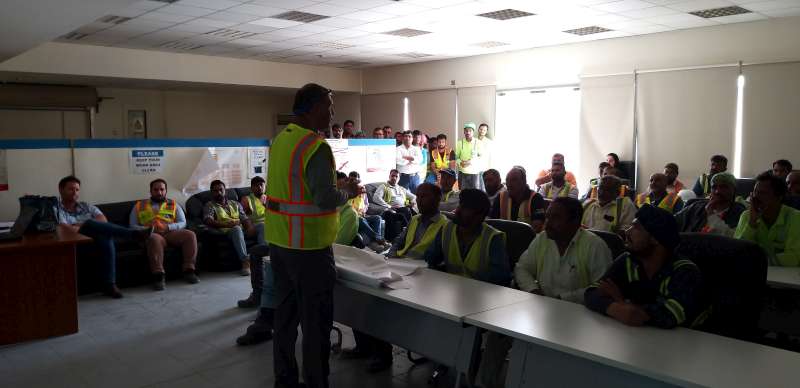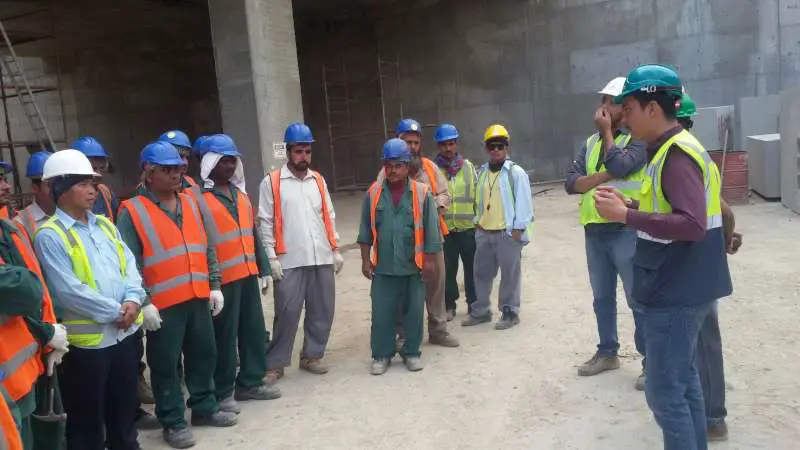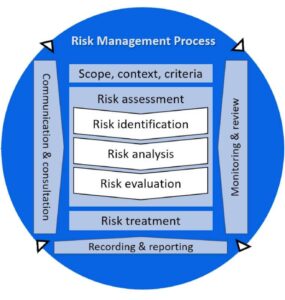How to give safety induction training?

Safety induction is very necessary and important for every worker before he is sent to the workplace. A workplace is consisting of many uncountable hazards and risks and if the worker is exposed to these hazards without proper information and instruction there is a 100% chance of an accident. And induction training must cover all work activities safety measures which are going on the specific project. For example, the induction training of a company which is attached in road works will be different from the company attached in high rise building. Free download safety induction form and Register at the end of this article. How to give safety induction training? a person mostly safety professional must try to cover all topics in his safety induction training and for this, he must consult with other team members from the construction team.

Induction training must be consisting of audio-visual activity it will increase worker’s perception about hazards and the video induction with different language translations will give workers more information and understanding especially those who have different languages and especially those who are not much educated.
For example, a worker who speaks Hindi only will only understand the Hindi language instead of the English language so for his full understanding the Hindi language must be selected instead of the English Language. A typical safety induction training must include the following points lets see what we need to add in How to give safety induction training.
Name of the worker:
Company Badge/ID Number
Date of induction training:
Trade of the Worker/Employee:
Health Status of the Worker/Employee:
Qualification details if any:
Then the following paragraph can be added as per requirement.
The above employee has been inducted on the Safety, Health and Environmental policy requirements of the Company prior to commencing work on the project. He/she has been made aware of his/her safety obligations to him/herself, his/her colleagues and the company. The topics included in the safety induction areas noted below.
Health & Safety Policy: has been explained to the worker and he is understood and confirmed that the policy is displayed.
Site safety systems in place: Safety Management System; Safety Committee.
Worker’s Representative – award system is clearly explained to the workers
Responsibilities: Management, Line Supervision, and Worker responsibilities; Ministerial Orders if any are elaborated and explained to the worker.
General safety & potential dangers:
Electrical equipment: Welding and cutting; Do not interfere with cables, boxes, etc – call a competent Electrician, do not open or try to repair electrical tools.
Cranes/ lifting equipment: Controlled by trained banks-men only; beware of overhead loads – swing areas – exclusion zones, be aware of lifting signages.
Machinery and tools: Danger of mobilized and mechanical equipment; guards and PPE – the right tool for the job – do not improvise.
Concreting operations: Heavy machinery/ equipment – cranes, transit mixers, and mobile pumps.
Fuelling operations: No naked flames – no smoking – no welding.
Abrasive wheels: Wear goggles at all times; Wheels to be changed only by trained personnel.
Gas cylinders/ LPG: To be stored upright – in a shaded and well-ventilated area.
Hazardous materials and restricted areas: Dangerous chemicals – signage –SDS – radiography (NDT).
Be aware of “pinch points”, “line of fire”.
Incident reporting: Report all incidents to your supervisor or Safety Officer – Supervisor to report the incident to Safety Officer.
Incident reporting: Report all incidents to your supervisor or Safety Officer – Supervisor to report the incident to Safety Officer.
Emergency procedure: Know your escape route; assemble in the muster/assembly area – refer to the evacuation route displayed.
Emergency contact numbers: Emergency numbers are displayed – know who to contact.
Fire prevention & protection: Only use a fire extinguisher if trained to do so – know their location.
Work at height: all required information must be provided e.g. When to wear full-body harness or safety belt from 1.8m height, how to use a safety belt, how to use a fall arrest system, how to use a retracting device etc.
First aid & heat stress: Know where the First Aid room is and who the First Aiders are; drink fluids regularly to avoid heat stress.
Conduct on-site: No alcohol and drugs – no arms and ammunition – no unlawful or disorderly conduct – violations.
Site dress code & PPE: Procedure for PPE issue and maintenance – to be worn at all times in the workplace.
PPE requirements – hearing: Dangers of noise – earplugs or muffs to be worn – warning signage.
Protection of our environment: Use toilets and welfare facilities – dust, noise, waste/ pollution and erosion control – fossils.
Housekeeping: The use of access routes, keep accesses clear – trip and slip hazards – keep areas clean and tidy – clean up spills.
Safe lifting technique: Plan the lift and route – check if clear. Bend your knees. When in doubt, don’t make the lift!
Work at height & ladders: Fall protection – edge protection – approved ladders – ladder secured – 1:4 slope rules.
Scaffold safety: Inspected and ‘APPROVED FOR USE’ – level, plumb, braced – decking, guardrails, mid-rails, toe-boards, access.
Excavation: Permits in place – services located – sides braced, shored, benched, sloped – barriers/ guardrails.
Blood-borne pathogens: Exposure to First Aid personnel – vaccinations – PPE and precautionary measures.
General rules & requirements: Speed limits – no smoking – security/ restricted areas – cell phones/ mobiles.
Additional training: Details of additional training explained.
I acknowledge that I have attended and understood the Safety, Health and
Environmental requirements of the country and company
Company safety induction and I agree to conduct myself in a manner compliant with these requirements.
Signatures of the person giving induction training.
Signatures of the person taking induction training.
you can also read our article on how to develop HSE policy
Like and subscribe our Youtube channel and get the latest videos on HSE training
we hope this article on How to give safety induction training was helpful for you you can download safety induction form and register below






